Home • Archives for Yana Popenkova • Page 2
Yana Popenkova
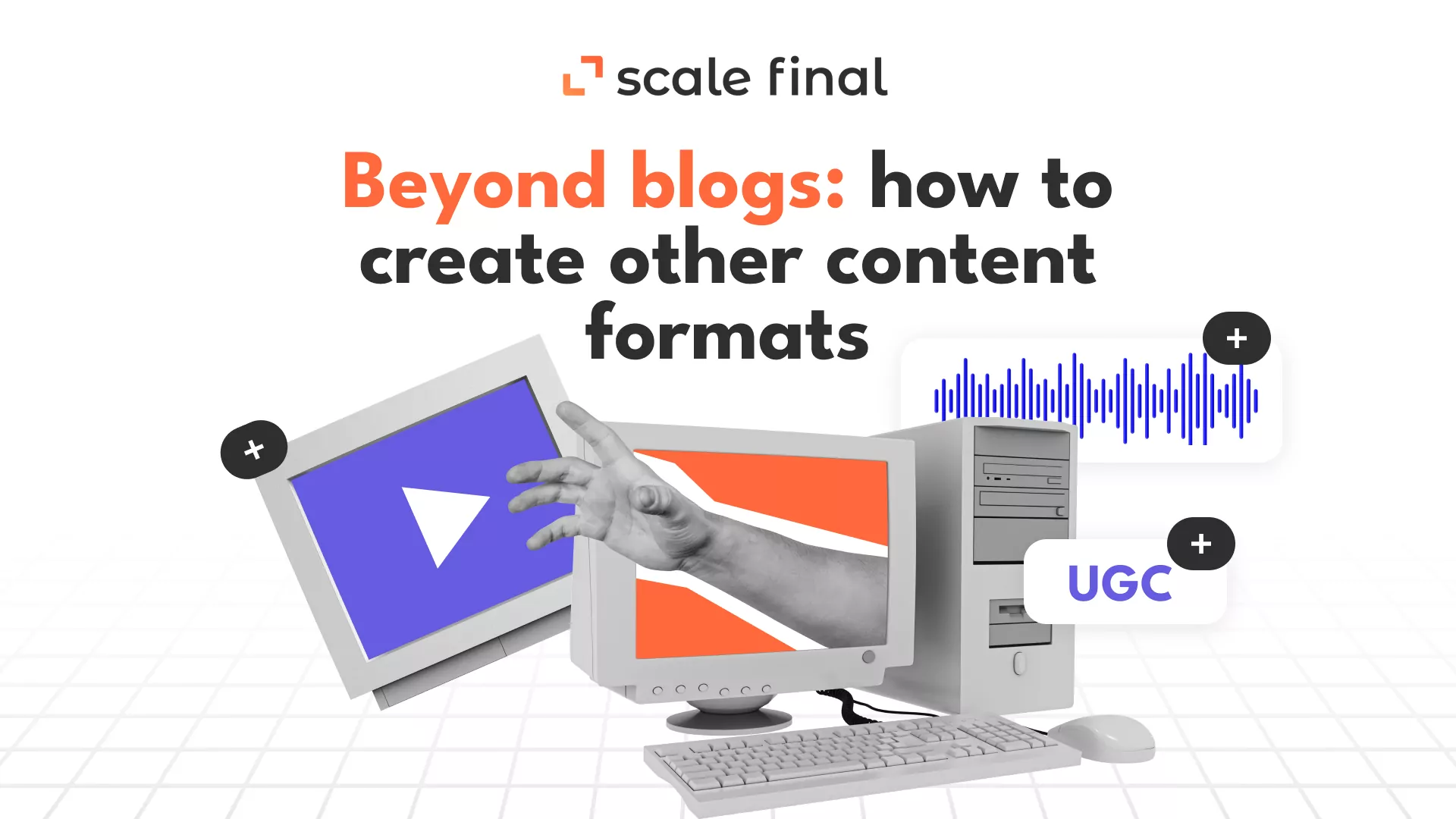
Beyond blogs: how to create other content formats
October 11, 2023Content Marketing
Content marketing is one of the most promising tools to make your company known online. It is so promising because it helps: But for content marketing to work, you should first research your target audience. Consider their needs and current trends. Finding suitable content formats is the key, considering different purposes and communication channels. In this article, we’ll introduce you to some content formats and show you how to create them effectively. Video content Video content is not new, but it is still a relevant and sought-after content format. According to Cisco, video traffic will account for 82% of all Internet traffic by the end of 2023. Advantages of the video content: Types of video content you can use in marketing: To create quality video content, you need to: Audio content Audio content is a relatively new but rapidly growing content format. According to Insider Intelligence, the number of audio content users in the U.S. will reach 212 million by the end of 2023. Advantages of the audio content: Types of audio content you can use in marketing: To create high-quality audio content, you need to: Interactive content Interactive content is a content format that requires active user participation. Advantages of the interactive content: Types of interactive content you can use in marketing: To create quality interactive content, you need to: If this is your gem, you can easily create interactive content with our quiz marketing guide: Quiz your way to success: boost conversions with quiz marketing User-generated content User-generated content is a content format that brand users create. Advantages of the user-generated content: Types of user-generated content you can use in marketing: To create quality user-generated content, you need to: Here you’ll also find some tips on how to encourage UGC: User-Generated Content (UGC) and its impact on your business Conclusion For content marketing to be effective, choosing the format is critical. Videos grab attention, audio provides intimacy, interactive content ensures engagement, and user-generated content brings authenticity. You need to ask yourself who you are and evaluate your business. Maybe there’s a gap you can cover with the content marketing format. Use each of these content format strengths to connect with your audience in a meaningful way.
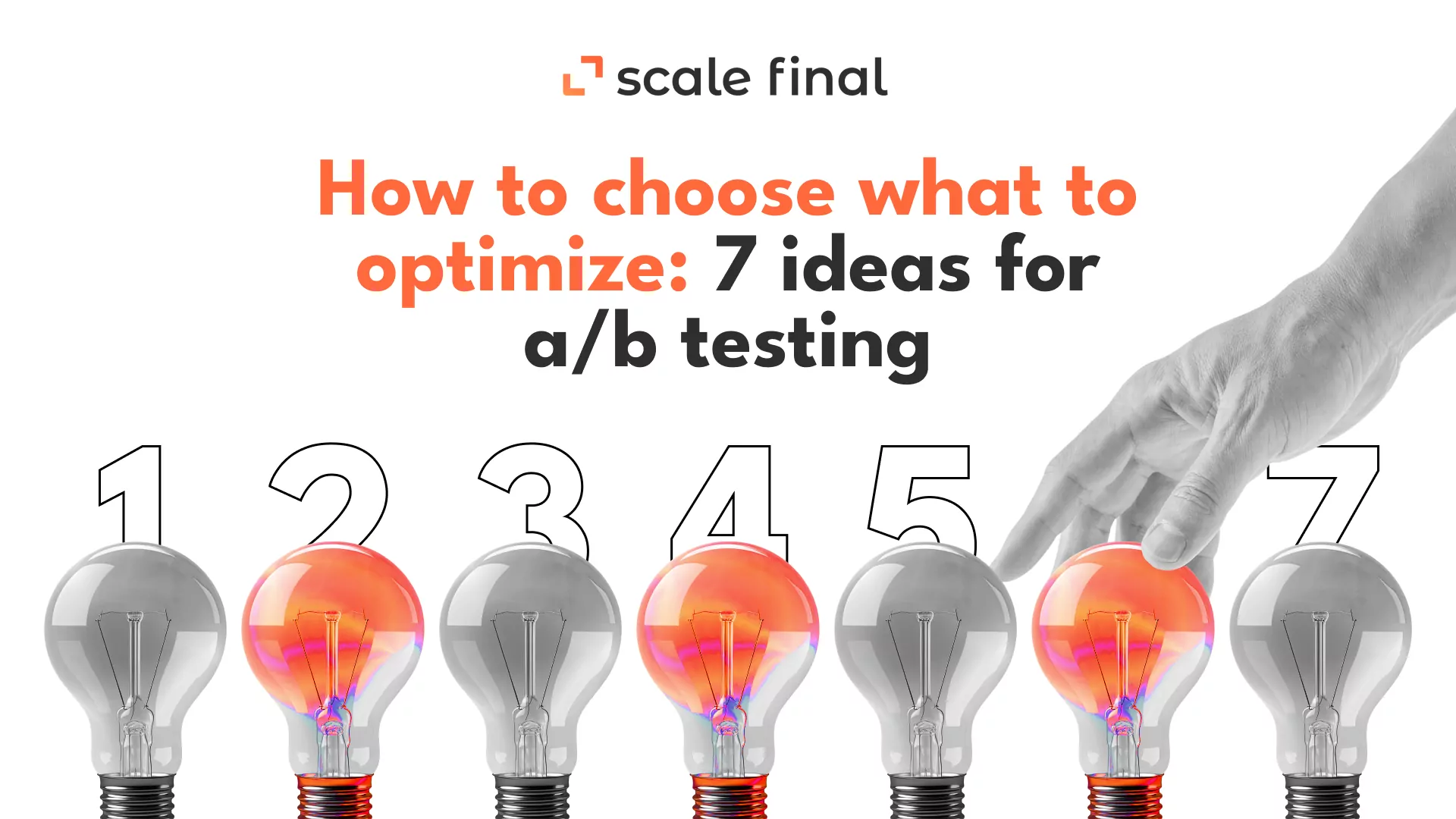
How to choose what to optimize: 7 ideas for a/b testing
September 28, 2023Optimization
There is only so much you can design and implement for your website to increase conversion rates. However, no blanket change will lead to more sales. To know for sure, you should test. Every CTA, design, and text on a website should not be done on the off chance. But you should start somewhere. We’ve compiled a list of the most important elements you should test, along with why and how. Before we get started, you can check out our previous posts on A/B testing: We have audited quite a few sites. We talked to clients, and the fear of the unknown exists. And the website design mistakes are similar. If you want to order a CRO audit Test pack from us, read this article first. However, you won’t get redesigned versions of your website and customized recommendations. To get tailored recommendations + AI eye-tracking insights, order CRO audit: Flexible 10-pack Now we give you a list of 7 blocks with ideas on how & why to test them. There is a bonus. Ask Yourself images for each of the blocks you should test & optimize. Hope you find them useful. Let’s dive in. Call to action (CTA) Visuals Copy Content Navigation Forms Email
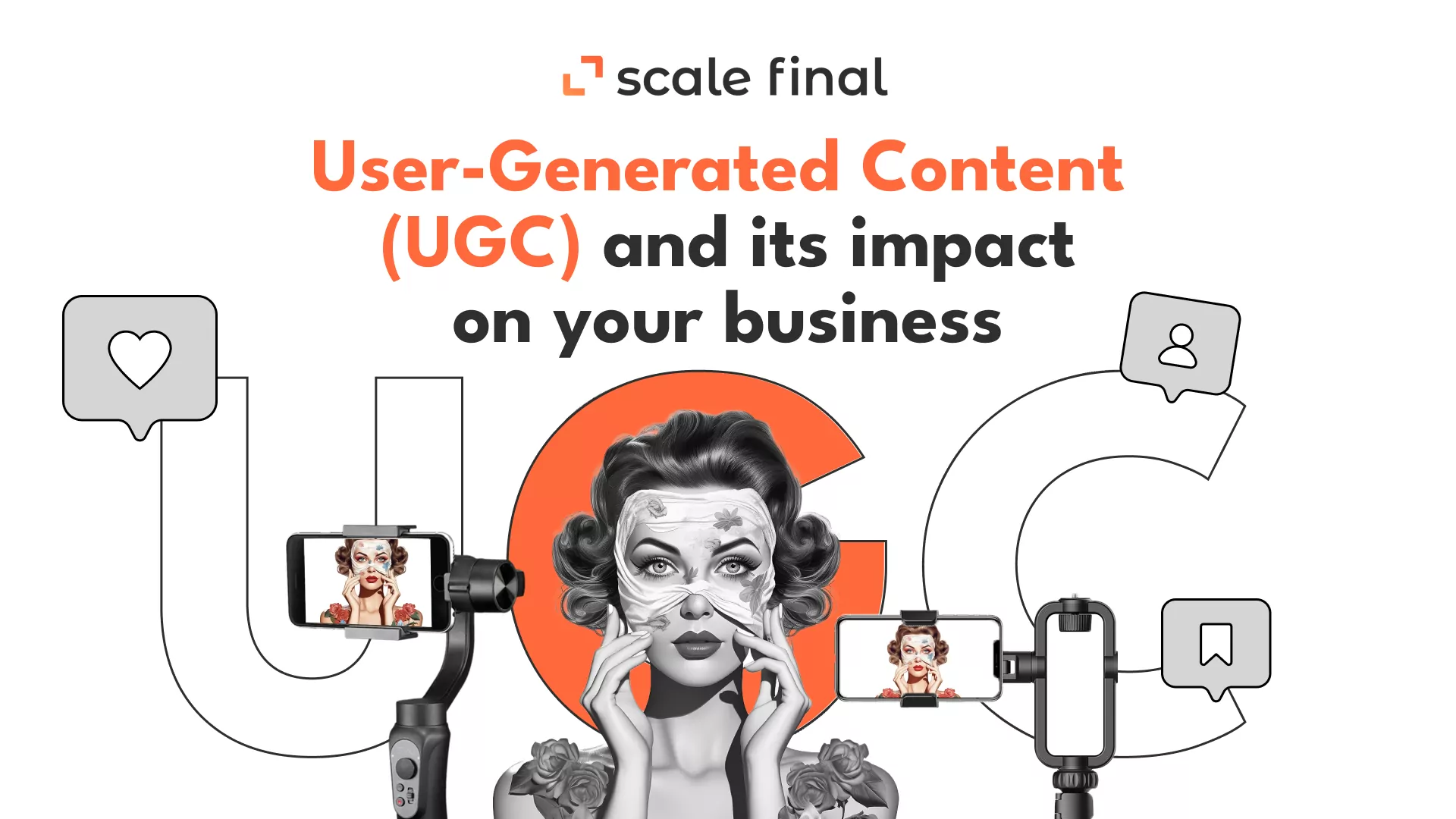
User-Generated Content (UGC) and its impact on your business
September 7, 2023Marketing
Introduction: What is UGC? User-generated content (UGC) is any content – be it videos, photos, reviews, blogs, social media posts, or any other form of content – that is created by unpaid contributors, often your brand’s customers or fans. Then you use it to promote your product. UGC is a win-win: both you and your users get benefits. Your business constantly receives new content that you don’t have to spend time or money to create. Your users feel more empowered and engaged. You, as a representative of a product or service, just need to directly or indirectly motivate your users to create and distribute the content. With user-generated content, the trust of the cold audience grows, because the opinion of other people is more important than the advertisement. People like to engage with other users’ stories. This is something authentic, real and genuine. This kind of content attracts new users much more effectively than perfect, “polished” advertising photos. Difference between UGC and influencer marketing In a previous post about influencer marketing, we sang its praises. But depending on your goals, you might also consider UGC (or a mix of two) because: Why you need UGC UGC is unbiased and genuine. User-generated content helps audiences explore customer experiences, which in turn builds trust. When UGC is used, it increases traffic and the number of unique links, which is an important criteria for website ranking. In other words, your brand’s website will rank better in the search engine when UGC is present. This, in turn, leads to a larger audience. User-generated content can be integrated at any point in the sales funnel: at the awareness, consideration, or decision-making stage. One of the main reasons why user-generated content has such a strong impact on conversion rates is that it is the most trusted and authentic content in the marketing ecosystem. As mentioned earlier, users are attracted to and feel engaged by reviews from real customers, which leads to an increase in conversions. Social media is the center of UGC, where billions of people research, gather and learn about products through user recommendations, customer reviews and visual content. Increased awareness leads to engagement with potential customers, which in turn means engagement with your brand. Engagement is undoubtedly the main goal of an online marketing strategy, as it positively correlates with conversions. Bonus: And that’s not all, because UGC is also cost-effective. Brands don’t have to spend additional resources on creating this content. Instead, they can focus their efforts on curating and promoting this content.Tip: Consider adding UGC to your content marketing strategy. For this, use our guide How to write content that sells. Part 4 How to encourage UGC Conclusion UGC is an organic way for you to connect with your audience, build credibility, and enhance your online presence. Influencer marketing offers unique benefits, but the spontaneity and authenticity of UGC carry their own weight. Brands that can effectively use both strategies will undoubtedly be one step ahead in fostering genuine relationships with their audience.
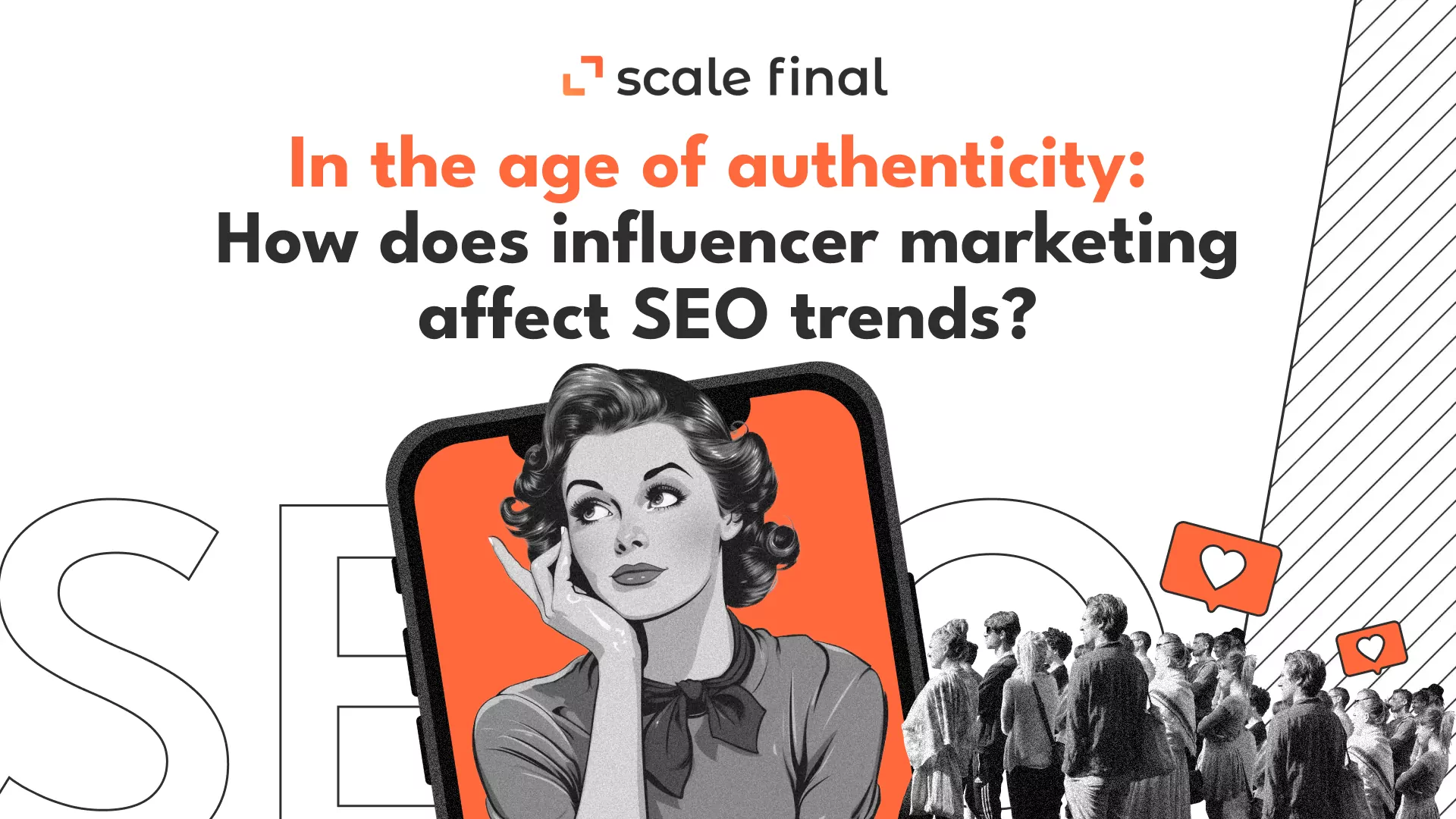
In the age of authenticity: How does influencer marketing affect SEO trends?
August 28, 2023Marketing
Gone are the days when brands were merely searching for celebrities to use as advertisers; today, everyday creatives are in the spotlight with their passionate and engaged audiences. With a projected valuation of $21.1 billion and the rise of AI influencers, the intertwining of genuine influencer partnerships and innovative SEO strategies is becoming increasingly important. Why are brands partnering with influencers, what unique tools do influencers offer? What trends exist now and are planned for the future – answers to the most critical questions from the marketing agency Scale Final. Let’s get right to it. Influencer marketing in a nutshell Analytics & trends The Influencer Marketing Benchmark Report 2023 shows that the future of influencer marketing is more than bright.The data applies to almost all jurisdictions, with as many as 3,500 marketers surveyed. Some bullet points: And interesting trends: However, you should follow some rules when doing influencer marketing. Despite the advantages mentioned above, influencer marketing is only good if it is honest and authentic. So that you and your fellow influencers to gain mutual benefits and communicate your values to the audience. Influencer marketing guidelines 1. Full disclosure. Influencers must explicitly mention sponsored content so the audience knows it is advertising. 2. Authenticity. Influencers should promote products they truly believe in and that their audience cares about. Advertising for profit can undermine their credibility. 3. Transparency. Brands should be open about their partnerships with influencers and also provide information about rewards. 4. Accountability. Both brands and influencers should be held accountable for the content of their advertising to ensure product safety and the legitimacy of advertising claims.Some of the well-known brands that are successful with influencer marketing include Patagonia, Dove, and Airbnb.So we’ve covered trends and analytics. Ethical questions about dealing with your audience. The next part is about influencer marketing and SEO, i.e. how search engine algorithms react to influencer content and how it affects your brand. SEO and influencer marketing The future of SEO will be closely linked to influencer marketing. More and more search results emphasise personal experiences such as short videos, Perspectives, Knowledge graphs, and Author carousels. There is a strong correlation between social signals and performance on Google, especially in Discover. Although Google has stated that social media is not a ranking factor, the correlation between the two is strong. This is especially true for YouTube, which Google increasingly includes directly in organic search results. Videos with many views on YouTube often take top positions in search. This is even more true for Perspectives. Google‘s addition of the new letter “E” (experience) to the word E-E-A-T was an important clue. The most innovative SEO strategies will involve real experts and contributors, and their online profiles will be the focus of all SEO activities. We can highlight the increasing role of in-house influencers, whose presence on social media will represent the brand. Learn how to build authority via an expert content strategy: How to write content that sells. Part 2 Google will understand even better who people are and what they do. Authenticity will become increasingly important. Conclusion The symbiosis between influencer marketing and SEO has never been more evident. This paradigm shift, backed by extensive analytics, demonstrates authentic content creators’ undeniable influence and potential in shaping online visibility and brand trust. As search engines prioritise authenticity and personal experiences, companies must remain agile and blend the worlds of influencer collaboration and innovative SEO tactics. This is the only way to ensure a meaningful connection with audiences and a stronger online presence.

Uncovering the complexity of B2B lead generation
August 11, 2023Marketing
Lead generation is all about finding the perfect way to turn prospects into loyal customers. But guess what? B2B lead generation sometimes feels like a puzzle that’s missing a few pieces. It takes a special approach. One that overcomes all the challenges and focuses on authenticity and building real connections. But not all specialists and agencies understand this and offer you quick wins or strategies for other types of businesses. In this post, we’ll go over how you should and shouldn’t go about B2B lead generation. How you shouldn’t approach B2B lead generation Very often B2B lead generation agencies offer a service like this: 1. You portray your ideal customer 2. The agency finds LinkedIn users who match the portrait 3. The agency sends them a bunch of intrusive messages. 4. The agency finds those people’s email addresses and bombs them there. These types of agencies won’t spend time on quality content. Nor will they spend time building connections between you and potential clients on social media.This type of work amounts to cold emailing without permission from users. It’s nothing more than multichannel spam. And this approach leads to low conversion rates. But that’s not even the whole problem. What’s the problem with cold outreach in B2B lead generation? Your company’s reputation drops below zero in the minds of those who have received these cold messages. Imagine if every one of you reading this post receives three private messages from us within a week offering to buy our service. And then you get the same message five more times via email. One of you might even buy our service. What about the other 1,000 people? It’s already difficult to run an effective inbound or ABM (account-based marketing) program. Never be seduced by quick wins like this. How do you go about B2B lead generation B2B lead generation is more complicated than the e-commerce cycle, which is: And this approach will also fail: Not only do you have to find the right way to generate leads, you also have to track where they come from. But even tracking software can fail. You’ll learn more about that later in the text. First, it’s Important to understand this: 1. B2B buyers rely on the recommendations of their peers when making a purchase This was true even before COVID, but thanks to COVID this process has accelerated dramatically. Instead of searching Google, “What tools should I buy to create TikToks?”, you’re more likely to go to a community in Slack and ask 13 CMOs. Or you email three people you met at a conference and ask them what they do. To back this up, here are some statistics from Evan Hughes: “Over 75% of website demo requests said they were made aware of the brand by a different source than the attribution software reports. Here’s the breakdown of SRA (self-reported attribution): 𝘏𝘰𝘸 𝘥𝘪𝘥 𝘺𝘰𝘶 𝘩𝘦𝘢𝘳 𝘢𝘣𝘰𝘶𝘵 𝘶𝘴…? 31% Colleagues/friends/word of mouth24% Internet/paid search/Google/Bing18% Community/G2/podcast/event16% Paid Social/LinkedIn/FB11% “Other” or N/A However, attribution software (HubSpot) reports: 82% Direct/Organic11% Paid Search2% Paid Social5% Other\Mix Despite those number, marketers still prefer attribution software over qualitative customer feedback.” This only led to: 2. You must invest in content Almost every SaaS becomes media. Founders are learning from their kids to make videos that take off on TikTok. People are still looking for things, they just have a lot more ways to look. 10 years ago, it was mostly Google. Today, that search can be on Instagram, TikTok, LinkedIn, in the community, in a LinkedIn group, at events, etc. A very typical way: 1. You listened to a podcast with a startup founder. 2. Then you watched his video from the conference. 3. Your former colleague told you how he implemented this software in his new company. 4. You Googled the company and clicked on “contact sales.” The marketing software tagged you as an organic user, but you can’t do anything with that information. This makes attribution a very difficult task. In consumer businesses, at times like this, they turn to “marketing mix modeling.” In B2B, there isn’t enough data for this kind of calculations. This approach doesn’t prioritize the channels that are typically used to generate demand because the attribution software is based on tracked digital touchpoints. This limits the marketing team’s ability to select the tools they can use to attract new customers. On top of that, we’re reaching limits every year on the Internet.A single source of truth for attribution has become a utopia. Using Google Analytics alone is no longer effective. It’s getting harder to track users across the web and iOS apps, and cookie-based strategies are losing their utility. Conclusion B2B lead generation is complex. The key is to build trust, deliver valuable content, and adapt to the changing preferences of your target audience.Avoid the pitfalls of cold outreach and focus on building genuine relationships, leveraging peer recommendations, and creating compelling content. By implementing these strategies and staying agile in tracking and attribution, you can overcome the challenges of B2B lead generation. You would position your brand for sustainable success in a rapidly changing environment.Tip: learn more about leadgen channels in a previous blog post: Lead generation or how to attract customers to your website
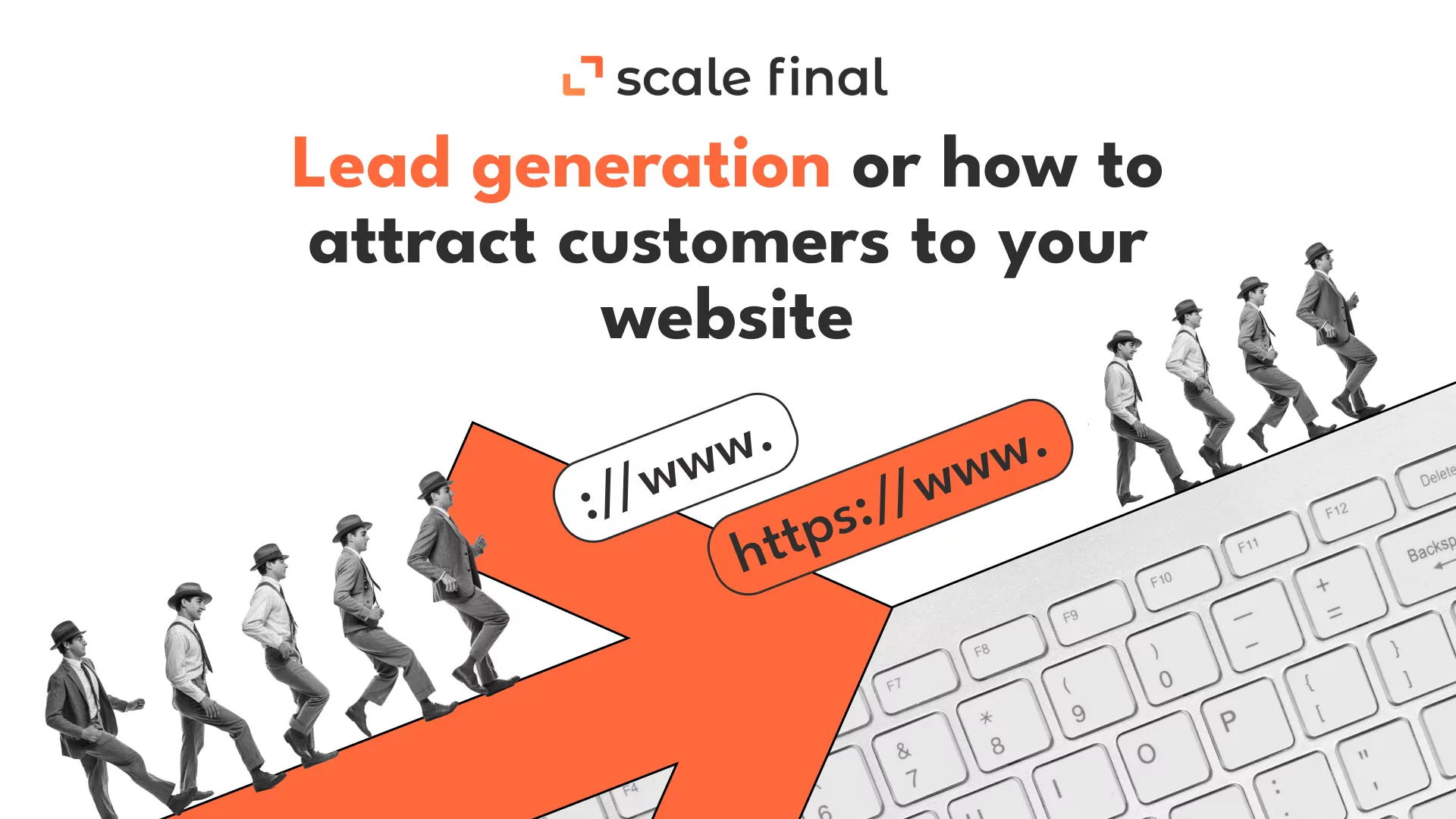
Lead generation or how to attract customers to your website
August 4, 2023Marketing
A user who wants to purchase or order a service on your website is called a lead. Both online and offline businesses need leads. In simple words, lead generation is finding potential customers and collecting their contact information for further interactions. Lead generation exists in every niche. Only the methods of acquiring leads differ, influenced by the specifics of your company’s field of activity. Both marketers and sales departments work on this process. The former combine SEO, contextual advertising, targeting and social networks. The latter focus on improving the work of customer support and sales managers. The ultimate goal of lead generation is to sell goods and services and build an active customer base. How to evaluate lead generation? You can evaluate your lead generation by quality and quantity of leads. If the quantity of leads varies from business to business depending on your goals, it is quite easy to assess the quality of leads. These are potential customers who: How do you capture leads on a website? Lead generation on the website benefits the business because if the visitor has left their data, they’re most likely interested in making a purchase. Even if they’re not planning to do it here and now. Another plus is that lead generation on the website requires less investment than buying other types of advertising or attending various conferences and exhibitions. The choice of effective lead generation channels depends on your business’s sales and development goals. Now for the lead generation tools on the website. Feedback form This is the first thing that comes to mind regarding lead generation. But there’s more to it than that. That’s why you must keep the following in mind when working with the feedback form: Follow these essential rules to make your feedback form a valuable and profitable tool. Lead magnet Another effective way to build your customer base is to offer a potential customer a free gift in exchange for a specific action: filling out a feedback form, subscribing to a newsletter, etc. For example, if you sell cosmetics for face and body care, offer potential customers a checklist to help them choose the right cream for their skin type, asking for an email and a phone number. Other options that work are: Your job is to offer the potential customer something of value, not just beg for their contact information. Newsletter The task of a lead magnet is to present a potential customer with a gift on a one-time basis, while a newsletter implies regular communication. And this tool must be used properly. Nowadays, there is an opinion that emails are a thing of the past, and nobody reads the messages sent. However, it is a great way to warm up the customer for an extended time and motivate him for additional orders or at least not let him forget that your company exists. You shouldn’t underestimate the newsletter because quality content will find its readers. Landing page The main goal of a landing page is lead generation and nothing more.A landing page should be sales-oriented, familiarize the visitor with the product or service, include a lead magnet offered in exchange for contact information, and at the same time advertise exclusively to your target audience. Tip: Feedback forms also work on the landing page, so you can combine both lead generation channels. Useful content If you’re told there’s too much content and you shouldn’t post it, don’t listen.In the vastness of the internet, most of the posted articles are of average and low quality, customers easily recognize this and therefore ignore them.Informative and relevant blog content on a website attracts potential customers, increases trust in the brand as a whole and strengthens your status as an expert in the niche. Read our guides on how to write content that sells: Part 1, Part 2, Part 3, Part 4 Note: That’s why it’s important to focus on the quality, usefulness and regularity of the content you publish. As a bonus, you can improve your SEO, climb to the top of search results, and get a steady stream of organic traffic that, if handled properly, will convert into leads in the future. Customer support Customers can’t always find the information they need on the website, so they contact online consultants for help.By writing a question to the chatbot, the user gets quick help, and you get the contact details of a potential customer.Among other things, a chatbot can respond to customers, because consumers are spoiled with fast service at a high level and unwilling to wait even a few minutes. Tip: to dive deeper, check out our B2B lead generation guide: Uncovering the complexity of B2B lead generation

Understanding PR: what it can and cannot do
July 28, 2023PR
In this article, you’ll learn which business goals PR can handle and which it can’t. And why for some of those you simply need a marketer or a salesperson. By the way, this is also the reason why many are confused about what different things like PR, SMM, advertising and so on mean. In a nutshell: Marketing – to understand, attract, and satisfying consumer needs PR – to create and maintain a positive image and reputation. Advertising – to get your message across and promote your offerings SMM – to engage and build community Why do you need PR? In short, businesses need PR to: PR -manager doesn’t sell the product or build a full-fledged plan for product promotion. A salesperson and a marketer should be responsible for this. But a PR manager ensures that your business gets positive mentions in the media and stays constantly in the info field: he thinks up topics for articles, seeks contacts with journalists and writes comments on editorial requests. Sometimes companies see a PR manager as a wizard and expect him to publish articles in the “top” media in his first month on the job. Few consider that Forbes isn’t interested in materials (even if they’re of the highest quality) from an unknown company. Breaking through the information noise is tricky: You must constantly work on your public presence. PR isn’t a short-term action. As you have already realized, you need to invest time and money. What PR can’t do? A PR specialist cannot influence all things in your business. You need to know that before you go to PR: PR can’t ensure customers don’t write hundreds of negative reviews about a bad product. It’s up to other specialists to monitor the quality of the product. PR can’t to improve the work of the sales department and customer service. If there is a constant flow of leads but no deals, the problem is within the company. Not in external communication. Selling a product is the job of advertising, not PR. Media articles familiarize people with the company, but they can’t sell them the product. PR influences buying indirectly – by building trust with the target audience. Everything in the business should work like clockwork: PR is only one of the marketing tools. You mustn’t forget the others. How to evaluate the work of a PR manager? You can evaluate the work of the PR department using simple calculations of indicators: However, there is a difficulty: a user may read an article, remember the name of the company and visit the site via a search engine the next day – the impact of the article can then no longer be tracked. Managers often ask customers how they learned about your business to assess PR effectiveness. Usually, the customer says: “I don’t remember, I heard it somewhere”. This means he might have read the company’s articles or heard the name from colleagues in the forum. Therefore, in practice, customer surveys as one method of calculating PR effectiveness usually don’t work. Conclusion If you place more hope on PR than it can justify, you’ll get a painful result: whatever it may be, the goal won’t be achieved. PR is one of the marketing tools that only works if the business has a comprehensive idea of why it needs publications in the media. If there is no insight, but you want to make sales, it’s better to think ten times before investing money and time in PR. In other words, this article is a reminder: You can always write us to help you with PR efforts.

5 signs that a marketing agency is helping your business grow
July 17, 2023Marketing
We begin today with a hot announcement. No, it’s not enough for the marketing agency you’re working with to meet KPIs. Although, of course, that’s important too. What should you look for when seeking an effective partnership with a marketing agency? You can only call a marketing agency great if they share your values. Only then can you call them your partner. You’ll learn why this isn’t too high a claim and what are the signs that an agency is interested in your company’s growth in our new text. Sign 1. Agency comes to you with initiatives You may come to an agency with a specific request: to increase brand awareness, attract new customers, or make a campaign for a new product. You don’t need to know how to achieve those goals. You don’t need to know about trends, new advertising channels, and analytics. An agency, on the other hand, tracks them every day. As a result, it knows in which cases the client can get more than it originally expected. And then there are two options: In the first case, everyone is happy: both the company and the agency make a profit. The second option is more complicated but has more potential: if your company grows faster, the agency’s business also grows. And if you see each other as partners rather than a marketer and a client, you’ll be more motivated to cooperate and look for growth points. Sign 2. You’re informed about problems and are offered solutions Projects inevitably have flaws. Things go differently than planned. And that is normal. What’s not normal is when you only know about problems once its too late – you’re behind schedule or not meeting KPIs. For example, you had a landing page error, a product order error, or an incomprehensible user scenario in the app. And in both cases, they suggest how to solve the problem. Sign 3: Your expectations are adjusted to more realistic ones People come to a marketing agency to spend less on advertising, earn more, and grow faster. But you can’t be 100% sure if your goal is realistic. If your company wants to grow by 230% per month, but the industry norm is a maximum of 30% per quarter, a good agency will tell you it is impossible. They’ll share statistics and their own experience. And by doing so, they’ll help you achieve the maximum results. And if they promise a lot in a short time – it’s a red flag. Ask lots of questions and find out where those promises come from so you don’t end up with stretched deadlines and unmet KPIs. Tip: Let’s take Scale Final as an example. Pay attention to the elements on the website that confirm our expertise: testimonials, case studies, and the About Us page. Sign 4. They share their expertise with ease You don’t just come to the marketing agency to achieve KPIs. You came for the expertise. But agency specialists start talking jargon. And when you don’t understand, they roll their eyes. This is not cool. And yes, we marketers know how to talk differently. If we want to cooperate, we will invest time and effort in explaining our actions. We also are willing to share expertise. Sharing knowledge with another person is always about dialogue. Your requests and concerns can be better understood. A client will work with a marketer because it’s easier and more fun.Tip: If you’re just picking an agency, check out their content marketing and social media. A good example is our PBN Service: We didn’t market it like it is a godsend, but we also created a comprehensive guide to PBN creation and how you can create it yourself: PBN ultimate guide. Sign 5. Agency invests in trust and builds a transparent feedback system In a long-term partnership, it’s crucial to check the clock constantly: Is everyone happy, is the company comfortable with the agency team, do you trust each other? Here are some types of transparent feedback systems: Here’s the final advice: We also have a related article but told from an agency perspective. Whether you’re a client or a marketer, we recommend you look into it: 5 worst tips to lose a client.

Quiz your way to success: boost conversions with quiz marketing
July 7, 2023Optimization
Fun, entertaining tests have always attracted users. Who doesn’t like finding out, “What type of pizza are you?”. Naturally, we all fell for the hype, and so quiz marketing was born. Tests not only help attract more users, but also make them a loyal audience. Of course, that’s only if quizzes are done right. Find out how a quiz can help increase your website’s conversion rate and what you need to do to make it happen. Questions covered: Why do I need quiz marketing? First and foremost: to increase conversions. Because the test is a kind of good deal for the user and the company. The visitor gets a good mood, a bonus, a discount or useful materials, and the company gets the contact details of the potential customer. In addition to high conversion rates, there are the following benefits: The quiz increases the time spend on the website, reveals the needs and interests of customers, allows you to lead them to purchase or order in a natural way and thus increases conversions and sales. Where should I add a quiz? We recommend testing three options and choosing the best one: Each of the options has its right to exist, so it’s important to test all methods to determine the maximum conversion. They also work great in a mix and complement each other. Why it’s important to test before implementing: CRO From Scratch. Part 2. What types of quizzes are there? It can be a survey, a test or a quiz. The task of the first is to arouse emotions and determine the interests of the target audience, there can be no wrong answers. Choose a test if you want to check the knowledge of your target audience to find out what kind of service they need. For passing the quiz, the user receives a kind of gift and is ready to leave his contact information for further communication. The content of quizzes may be: Find the right content type that covers the intentions of your target audience: How to write content that sells. Part 1 Regardless of the chosen quiz type, your main task is to add fun and great pics. We also recommend using step-by-step statistics when testing different types of quizze. For example, to determine at which question users stop taking the test. Make adjustments accordingly. How do I create an effective quiz? Our recommendations for quiz marketing

How to understand eye tracking: most common terms
June 21, 2023Optimization
To understand eye tracking, you don’t need to take anyone’s word for it. Eye tracking terms are complex, but we’ve broken them as simply as possible so that you can make your assumption. Although we explain in our reports in words and graphically what and how we measure, it’s not too much to understand before ordering whether specific metrics are worthy of your attention. If you missed our eye tracking guide, we suggest you read it before this one: Leveraging AI eye tracking for effective marketing: what you need to know Below you’ll find the most common eye tracking terms and, more importantly, what you need them for. 1. Gaze points and fixations Gaze points are the areas eyes land. Fixations are clusters of gaze points that are close together and eyes sit on them for some time. Why did we decide to put two terms into one section? Although both are the basic metrics of any eye tracking study, gaze is more raw data about what exactly a user is looking at, while fixations may give you insights on why they’re paying attention to it. Why are they important? Gaze points: Fixations: 2. Heatmaps We explained heatmaps in a general post about eye tracking (link is above). A brief summary: It’s a color-coded visual representation of fixation areas. Warm colors – red and orange are where the most attention, cold colors – green and blue – the least. Why is it important? Heatmaps provide an overall view of your website and are really fun to decipher. Gaze points and fixations, on the other hand, provide detailed insights into user attention. 3. Dwell time A familiar term from CRO and SEO, but in eye tracking it means something different. Dwell time calculates how much time one spends looking at certain areas/elements. This includes the fixation with which one looks at certain elements, as well as the time they switch attention between fixations. Why is it important? 4. Area of interest (AOI) Area of Interest (AOI) is an area you want to target for analysis. It can be specific parts of a web page, product, ad, or any other visual element you want to use to measure user interaction. This metric is best for comparing data for different AOIs. Why is it important? Why should you choose Scale Final AI eye tracking CRO reports? Understanding these key eye tracking terms can help improve user experience, optimize design, and increase engagement on your website. With this data from gaze points, fixations, heatmaps, dwell time, and areas of interest, you can make strategic decisions that align your users’ behavior and preferences with your business goal. Remember, the goal isn’t just to collect data, but to analyze it effectively and use it to drive positive results. Contact us today to learn more about how our AI eye tracking CRO reports can help you achieve that goal.

Leveraging AI eye tracking for effective marketing: what you need to know
June 14, 2023Optimization
We’ve said many times that you shouldn’t rely on your intuition in marketing matters. For example, in matters of design, testing, launch, etc. We’ve said that you should always rely on data. How to collect and analyze it, you’ll learn here: CRO From Scratch. Part 1 But what if you’re at the very, very beginning and want to make it super cool right away? How can you beat the competition? How do you make sure you don’t lose the already limited attention of your visitors? In Neuromarketing is gold? (spoiler: the answer to this question is no) we wrote about cool but complex behavioral studies, including eye tracking. Why it’s cool, but still complex, later. You’re probably here for a reason. Because we also use AI eye tracking in our CRO reports. Not only do we benefit from this, because our arguments are supported by predictive analytics, but so do you. It saves you a lot of money and time. Not only time for hypothesis testing, not only for testers, but time for the whole product cycle and for the whole team. In this text you’ll learn: What is traditional eye tracking? Eye tracking studies are traditionally held in a lab-like setting to measure eye movements. They were first used by neuroscientists and then adopted by neuromarketers and marketers in general. These studies can predict fixation points and even the order of eye movements. Respectively, you can also determine what’s getting little or no attention. In most of these studies, you need a lot of subjects to get reliable data and special equipment. Screen-based trackers observe eye movement relative to a flat display. Wearable trackers, such as eye-tracking glasses and VR headsets, are used in more active or real-world scenarios. Webcam-based solutions are a cost-effective alternative but may be less accurate. Another key concept in eye tracking is heatmaps – color-coded summaries of gaze points. Red typically represents the most viewed areas, while green represents the less viewed. These visualizations help make sense of the vast data collected in eye tracking studies. What are the pros and cons of traditional eye tracking? It gives you data on what’s attracting attention, and that takes the guesswork from all phases of product development. Some of the equipment can cost up to $10,000, and that’s just the middle-end equipment. However, the device you need depends a lot on the industry you’re working in. Assuming you’re a digital marketer, the equipment itself will cost you an average of $1,000. Then you have to keep in mind that at least 39 users should participate in the study. So you need to multiply each number by 39. You can buy these studies as a service from special companies, for example, Eye Square. But to get the result you still need a lot of time, because one test takes up to 60 minutes. What is AI eye tracking? The amount of data collected during the years of traditional eye tracking hasn’t disappeared into oblivion. All that data was fed into AI prediction models, and the AI eye tracking tool was born. Predictive AI eye tracking simulates human vision. AI heatmaps like the real ones show which areas of visual elements people prefer to look at and which they don’t. On average, it simulates the first 3-5 seconds of user attention. Just like traditional eye trackers, it determines whether the visual hierarchy is clear, which elements attract attention, and how the gaze moves between them. The AI Eye Tracker can predict the real user’s attention with 90-95% accuracy, which is quite impressive considering that the study takes only minutes and costs far less money. Discover more AI tools here: Conversion intelligence: AI for CRO This is exactly what our tool, ScaleFinal eye tracking does. We use it extensively in our CRO reports to help businesses increase their conversion rates by changing web pages, landing etc. based on eye tracking studies. No special devices, data, or users are required. What sets our AI tool apart is the team of professionals with diverse backgrounds in digital marketing that work on each report. We know that every business is unique. That’s why our team of SEO specialists, UX /UI designers, and CRO experts work together to tailor it to each client’s specific needs. By leveraging all of our expertise, we ensure that eye tracking data is interpreted accurately and meaningfully for your unique context, leading to actionable recommendations that drive results. How does AI eye tracking work? The AI algorithm is an ever-learning, self-improving data sponge. These sophisticated deep-learning algorithms are trained with tens of thousands of images from actual eye tracking studies. As the AI sifts through these images, it recognizes certain patterns in how users direct their attention and neatly catalogs them. This allows the AI to make educated guesses on what will attract attention. As you feed these algorithms more data, they get better and better at predicting where people’s eyes will go. Currently, the hit rate of academic visual saliency prediction models (a fancy term for predicting where eyes will land) is 90-95%. What are the pros and cons of AI eye tracking? With AI predictive modeling, the entire team can use the tool, especially in the pre- launch phase. No more wrangling and guesswork over product page blocks, lengthy data collection, web development and design. AI tools are, on average, much cheaper than traditional tools. Even the agencies proposing AI eye tracking as a service charge less. The accuracy of AI predictive eye tracking is 90-95% compared to human studies. Still, this number is quite high. Think of it as a trade-off for lower cost and less time. With some of the traditional eye tracker devices, you can gather a lot of different data from the real world. But if you’re reading this text, that may not be a disadvantage for you. How can you leverage AI eye tracking? 1. Arguments for design decisions to customers Whether you’re in marketing, advertising, CRO or web development,

The future of content: AI revolution
May 25, 2023Content Marketing
Hi everyone. We talked about content strategies in a series of posts. We also once covered the topic of machive vs copywriter. We showed you just one angle on what’s happening now. Namely, the AI revolution. The biggest breakthrough since the creation of the Internet. I’m not going to tell you that you have to compete with robots. Rather, the point is that we content creators have already changed. Even the content you see now is no longer published in the traditional way. It wasn’t that the copywriter made a research, pitched an idea to the department head, the department head approved it, the copywriter wrote it, passed it on to the editor, and the SEO team started optimizing it. With the AI tools we’re using now, we can speed up the work. I’m not saying it makes the content better. It just makes the workflow faster. So what we call embracing AI lies in the plane of speed. As our CEO, Sviat Pinchuk, said in his personal blog, AI is just a technology. A technology that allows us to work faster. In a way, it’s better if KPIs are the only value for you. But we all know that’s not the case. We all want to keep doing something that truly benefits our customers. So there’s no talk of replacing the copywriter with a machine. Yes, our work has changed, but this is certainly not the first time that’s happened. No more panic, let’s look at how the content publishing workflow has changed with the AI revolution. Point 1 of content creation Research is the starting point for every content creation. We used to think about what users would google. We monitored social networks to find out what our customers/potential customers were talking about. We looked for ways to better solve their problems. This kind of work takes a lot of time. We take time to evaluate this information. It’s not just about satisfying the search engine robots, but more importantly about making our content visible and as useful as possible for our customers. After brainstorming, we would organize their ideas into tables and add 2-3 sentences to describe the idea. At Scale Final, for example, we use Miro at this stage to create an interactive visualization map. It takes time. Then, finally, we write this text. On average, one or two days? We don’t want it to be dull content. Why it’s important to write content with real value: What makes a good copywriter? We write, edit, edit again. Send it to the editor. Get the final version. Now it’s the SEO team’s turn to optimize the text. Does this sound familiar? I’m sure it’s similar in your team. How much time does it take to create good content? Quite a lot. Times have changed with the mass adoption of AI. And you’ve probably noticed how it reduces the time you have to work. Point 2 of content creation Everything starts in order – with research. We don’t have to guess to find the right keywords. There are many free apps that can help you determine the keywords. For example, Semrush. Now you can do it in minutes. With social network analysis, it’s the same. Each network has its own AI analytics system. You can see what topics come up most often in your customers’ circles. Next, you can use generative AI, such as ChatGPT. You create a prompt by entering keywords and topics from your research. You can also ask them to create a few variations of the title for you. You can also create a draft text. Play with the tone of voice and make as many changes as you want. You gather all the data, arrange it in front of your eyes, and then the fun part begins. Why this process makes no sense without you. You’re the one who evaluates the result. You’re the one who is responsible for making the text human and readable. You’re the most important link that checks if all the facts in the text are true. If your main goal is to create high-quality content and if it’s important to you that it’s useful for your readers, we have good news for you: You’re indispensable. Besides publishing, you also have the task of distributing it. You have to see if everything went according to plan. Most importantly, you need to learn from your work and from your mistakes. Even if with the help of Aritificial Intelligence. The AI revolution has already happened, and the tools will change and get better. We mustn’t forget that they’ll get better with our help. And also why we’re doing all this in the first place.




